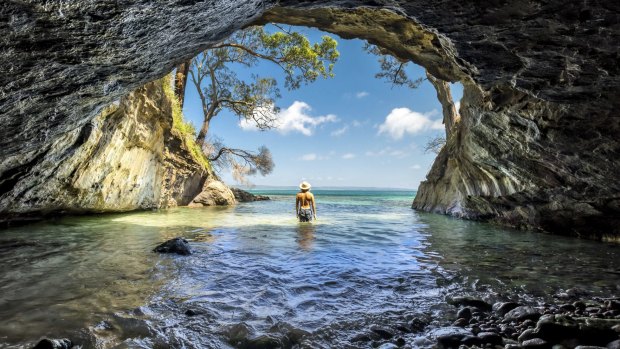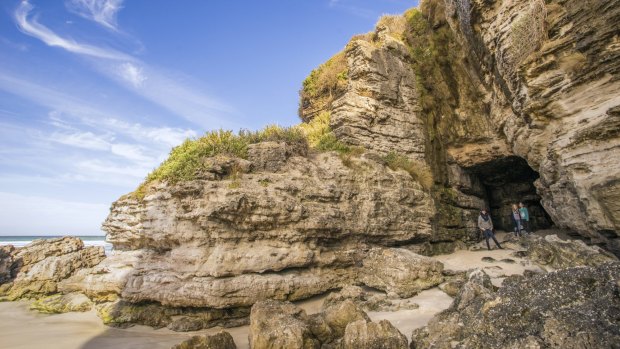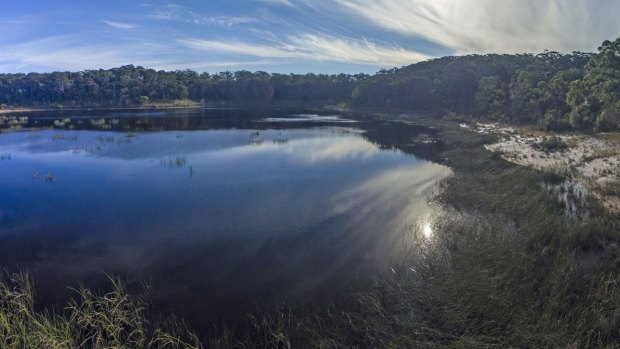This was published 1 year ago
Jervis Bay Territory: Australia's weird, little-known third mainland territory
By David Whitley

Booderee National Park in Jervis Bay Territory.Credit: Jordan Robins/Destination NSW
Cave Beach is extraordinary. The squeaky white sand gently curves off into the horizon, while the wet sections twinkle in the sunlight.
Surfers roll in towards the shore on crisp, evenly breaking waves. And children break off from playing with their buckets to investigate the rock tunnel that gives the beach its name. The cave mouth feels like it ought to be the gateway to a secret temple in an Indiana Jones film.
Every Australian state will argue that it has the best beaches in the country. But Cave Beach – and several other indisputable stunners nearby – suggests that they're all wrong.

Cave Beach's cave mouth feels like it ought to be the gateway to a secret temple in an Indiana Jones film.Credit: Dee Kramer/Destination NSW
Cave Beach is in the Jervis Bay Territory, a weird political and geographic anomaly that most people overlook when drawing mental maps of Australia.
The Jervis Bay Territory was carved out of New South Wales in 1915. At the time, it was felt that the Australian Capital Territory needed access to the sea and a port. Given that creating a land corridor would involve ceding an unreasonably large amount of land, it was decided to keep the two territories separate.
In the end, a peninsula on the southern side of Jervis Bay was deemed the best bet. New South Wales relinquished 67 square kilometres of land, and the Jervis Bay Territory was born.

Lake McKenzie in Booderee National Park.Credit: Dee Kramer/Destination NSW
The sign above the Jervis Bay Supermarket in Jervis Bay Village says that it is part of the ACT. But this isn't the case. The Jervis Bay Territory, population 391, is not part of the ACT and never has been. It is Australia's third mainland territory, and the one that all but the most pedantic pub quiz nerds will never include in the count.
It does, however, get lumped in with the ACT. The Jervis Bay Territory is represented in parliament by the ACT senators, and the Member for Fenner, which is largely made up of the ACT's northern suburbia.
With a couple of small exceptions – cannabis laws being the main one – ACT law applies in the Jervis Bay Territory, and the Australian Federal Police perform cop duties. If something needs to go to court, the case is heard in Canberra. And Jervis Bay Territory cars have ACT number plates.
But the confusion doesn't stop there. Naval college HMAS Creswell is effectively cocooned off and left to run itself, while most local services are contracted out to neighbouring councils in New South Wales. The City of Shoalhaven sorts the bins, for example.
Ninety per cent of the Jervis Bay Territory, however, is Aboriginal land, owned by the Wreck Bay Aboriginal community. The Wreck Bay Village is one of two villages in the territory, and it is generally off limits to visitors. However, the rest of the Aboriginal land forms the Booderee National Park. And, just in case things weren't confusing enough, this is jointly managed by the Wreck Bay community and Parks Australia.
And, for most visitors, this is the bit that matters. Nobody is going to visit the Jervis Bay Territory to say hello to a federal police officer or spot a City of Shoalhaven bin lorry.
Entering the territory feels like a proper, old-fashioned border crossing. On the road in, you need to pull up at a booth and pay your $13 national park entry fee.
Once paid up, there are a couple of attractions worth allocating a bit of time to. In the east of the Territory, the ruins of the Cape St George Lighthouse are hugely atmospheric. Interpretive signs outside the lighthouse detail the trail of disaster that befell the people who lived there, while if you come in winter, there's a good chance of seeing migrating whales from the clifftops.
Head south towards Cave Beach, and there's the Booderee Botanic Gardens. These are the only Aboriginal-owned botanic gardens in Australia. They are elegantly laid out, and a pleasure to stroll around. Signage is, alas, patchy, and the guided tours have been suspended for Covid reasons.
The beaches, though, are the real lure. Murrays Beach at the northern tip of the territory is usually considered the star. The sand is a dazzling white and the calm, low waves are ideal for swimming and kayaking. Get lucky, and you might see one of the little penguins from nearby Bowen Island, hunting for fish.
The beaches continue in largely the same fashion around the bay, many backed by rudimentary campgrounds. There's a touch of tropical island dream about it.
At the same time, this is unmistakably Australia. On the walk back up to the clifftop car park from Cave Beach, a kangaroo guards the path. It gives the returning surfers a quick look, then bounds away, jumping over the gate. It, like everyone else at Cave Beach, is supremely unbothered about political status and governance structures.
TRIP NOTES
MORE
VISIT
A two day pass for the Booderee National Park costs $13 per vehicle.
STAY
Unpowered camping sites within the national park cost from $25 a night. Otherwise, stay in nearby Huskisson. The Huskisson Beach Resort offers colourful bungalows for from $100 per night. See huskissonbeachresort.com.au
David Whitley travelled courtesy of Tourism Australia.
Sign up for the Traveller Deals newsletter
Get exclusive travel deals delivered straight to your inbox. Sign up now.